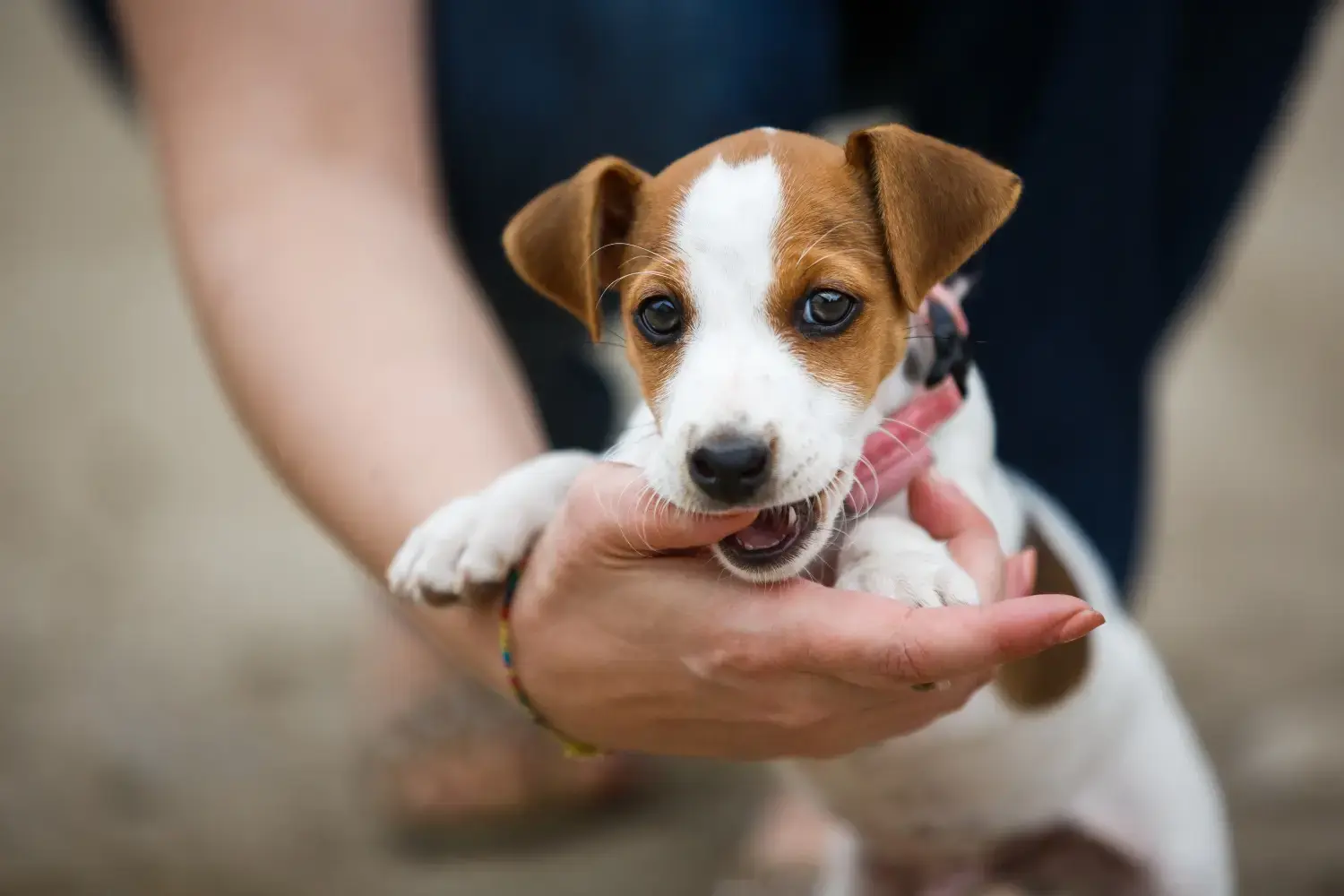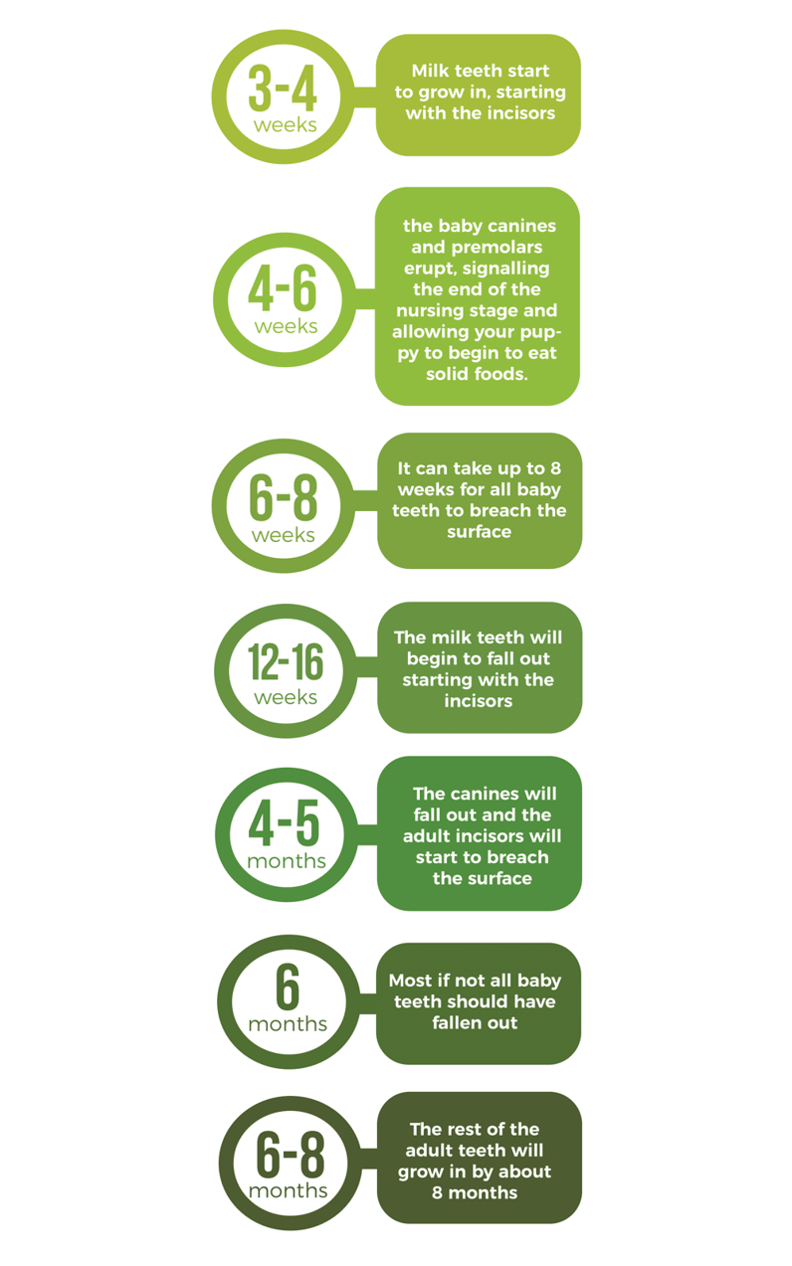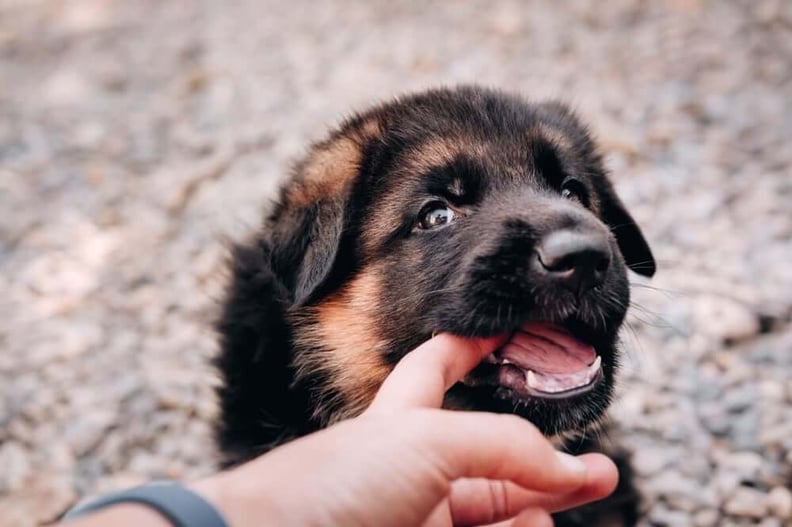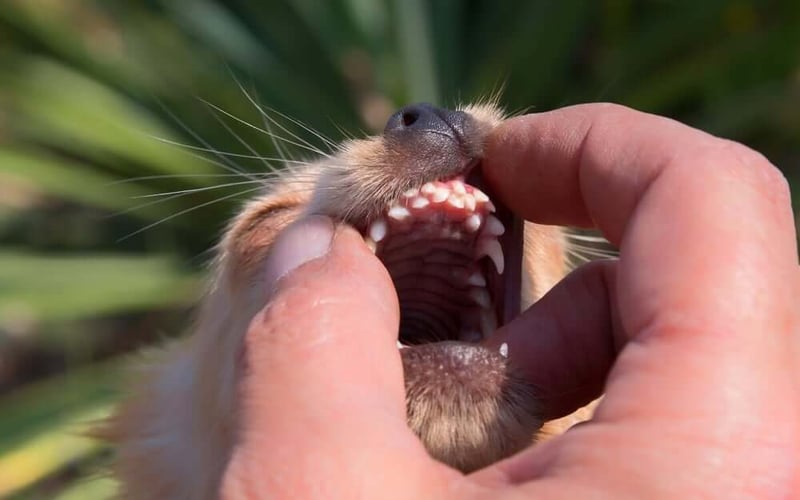
There is no more universally dreaded part of puppyhood than the teething stage. Learn what to expect from a teething puppy and get some simple puppy teething solutions to help ease their discomfort and minimize some fo the behavioural changes that teething can contribute to.
Your puppy’s teething stage is no picnic for you or them. As their teeth move, fall out, and move again, your puppy will experience pain and discomfort that can lead to discomfort and even cause destructive and unhealthy habits to develop.
Understanding the puppy teething stage better and knowing how you can help reduce the symptoms of teething can make the whole process a little more pleasant for you and your puppy.
In this blog, we'll break down what is puppy teething and how you can spot and treat symptoms of pain and behavioural changes and keep your pup, your fingers, and your house safe.
What is Puppy Teething?
New puppies can be delightful, but they can quickly turn into adorable little monsters when they start to teeth. But why? What happens to your puppy during teething that makes them so destructive?
The first set of teeth your puppy will get are commonly called milk teeth, but the technical term is deciduous teeth, meaning they are temporary. The term milk teeth is used because the presence of those sharp puppy teeth signals to the mom that she needs to start weaning her pups as nursing starts to become painful for her.
Puppies have 28 milk teeth that fall out to make room for their permanent adult teeth, of which they should have 42.
Teething happens in 3 stages:
-
- Milk teeth grow in
- Milk teeth fall out
- Adult teeth grow in
Throughout the process, your puppy’s mouth will be tender, and their jaws will be sore. Not only are teeth erupting through the surface of the gums, but the teeth below the surface move, making not just the gums but sometimes their whole jaw tender.
Puppy Teething Chart
Understanding the puppy teeth chart will help you be better prepared. Most puppies go through the teething process normally, but some don’t follow the average timeline, so don’t panic if your puppy is a little off-schedule. Let’s go over the standard puppy teething timeline:

The teething process typically lasts about 4-6 months of age in total. Most puppies don’t leave their mothers until around 8 weeks of age, so you will likely miss the majority of the initial milk teeth phase.
You may be concerned if your puppy is losing baby teeth, but you haven’t found any teeth lying around. Totally normal! You may find one or two, but the reality is that puppies often just swallow the tiny teeth when they fall out.
It may seem gross to us, but it's totally harmless for puppies.
Puppy Teething Symptoms
Supporting your pooch through the teething process isn’t hard, but you do need to be able to identify signs that your puppy is in pain. So, what kind of behaviour can you expect from a teething puppy?
Every puppy handles teething differently. If you are lucky, you may not even notice your puppy’s teething stage, but for most, teething will lead to some easily identifiable behaviours. Here are a few signs to keep an eye out for:
-
- Chewing
- Biting
- Whining
- Suckling
- Change in eating habits
- Bloody saliva
- Abnormal drooling
You can’t stop this natural stage of development, and it’s not easy to watch your puppy suffer, but if you can identify symptoms of teething, then you can take steps to reduce the pain, discomfort, and destructive behaviours.
How to Stop a Teething Puppy from Biting

OUCH!! That’s what you say when you get nipped by your puppy’s razor-sharp teeth. Your sweet little pup is not trying to be aggressive or mean-spirited; he’s probably just teething!
During the teething process, you may find that your dog is chewing more intensely and even chewing things that they normally wouldn’t. Teething puppies may try to chew on fingers or toes, clothing, furniture, and just about anything else they can get their little mouths around.
This might be a little annoying, and sometimes expensive, but rest assured your puppy is not trying to be a jerk. They are simply looking for ways to ease the discomfort of teething.
What to Do When Your Puppy Bites You
So the million-dollar question you might be asking is - How to get a puppy to stop biting?
The puppy stage is when many bad habits are formed, and these habits can be much more difficult to correct later in your dog’s life. When your puppy tries to take a nibble of your fingers, offer a toy, chew or treat in replacement.
The best method is to have puppy chew toys available before you start playtime. Being proactive is always better than being reactive.
Before you brought your new puppy home, the bulk of their training came from their mom, their littermates, or other animals that they may have been housed with. The best way to start any puppy training is to treat them the way another dog would.
When they bite - yelp! This is how puppies say ouch! It's also how their brothers and sisters told them that they were playing too rough.
It seems a bit silly, but it will get their attention and help them understand their boundaries quickly. Yelps should be quick and high-pitched, like a puppy. This is especially important with children because your puppy will not see your kids as the leader or dominant in any way; they will more likely treat them like their littermates.
If you want to protect your furniture, clothes, shoes, and even your fingers, keep reading to learn about what you can do to soothe your puppy's teething pain and curb their bad chewing habits.
Puppy Teething Relief
We know that teething is not pleasant, so many pet owners wonder how to help a teething puppy who is in pain. Well, it turns out puppy teething relief is very instinctual, and young puppies look for ways to relieve the discomfort all on their own; Mainly, chewing.
While your puppy’s teeth shift and fall out, the gums will be extra tender. It may seem counterproductive, but chewing is one of the best ways to relieve that discomfort. If you don’t offer them appropriate things to chew on, they will chew on whatever is convenient.
5 Puppy Teething Tips
If your puppy is biting, sucking, chewing, or just being an absolute menace, he might feel pain from teething.
Puppies already explore with their mouths, so it doesn’t matter to them what they are chewing as long as it feels good. Here are a few puppy teething tips you can use to help curb destructive chewing behaviours:
1. Best Toys for a Teething Puppy
For more aggressive and long-lasting chewing sessions, puppy chew toys are going to be a safer option. Toys specifically made for puppies will be a little softer, so they feel better on the gums as they chew, but still durable enough that most puppies won't destroy them too quickly.
No toy is indestructible, and many powerful jawed breeds will use their sharp puppy teeth to shred the toys, so make sure you keep an eye on them and take away the toy if it starts to come apart.
Here are a few of our favourite puppy teething toys:
Always try to keep toys close by so you can redirect any of your puppy's destructive chewing habits to their favourite chew toy.
2. Freeze to Numb the Pain
A tip that many pet parents know from their human baby's teething experience is that cold feels really good on sore gums. You can take a clean washcloth, a hand towel, or an old t-shirt, soak it in clean water, and then freeze it.
Check out the Canada Pooch Freeze and Chill Cooling Pals toys for a simple and fun option to ease teething pain. Simply wet the toy, freeze it, and let your puppy play.
This is a soothing chew, as the frozen fabric will help numb the tender gums and feel good on the teeth as they work their way through the surface of the gums. This type of toy should only be used when you supervise them and should be taken away once defrosted to prevent them from destroying or eating it.
3. Natural Chews for Puppy Teething
Your puppy will have a natural instinct to chew on everything and anything to help work those teeth out faster. Offering a healthy, natural chew will soothe their tender gums and reduce the destructive chewing habits that come hand-in-hand with the teething process.
When looking for a chew for your puppy, you have to consider how hard it is and how it will break down. Many chews, like smoked bones and antlers, are meant for tough chewers and will be too hard for a puppy’s delicate teeth.
This can make it challenging to help them through the teething phase. The gums will be sore, and a hard chew could make the pain worse. Worse still would be if they were to damage or break a tooth.
Fortunately, many softer chews are safe for your puppy to eat. Here are some of our favourite puppy-safe natural chews to help them reduce pain from puppy teething:
Natural chews have many nutritional benefits, but are also excellent for supporting dental health. Find out which Long-Lasting Dog Chews can help keep your puppy healthy and busy.
Natural chews add extra calories to your dog's diet, so keep that in mind when you decide how many and how often you give your puppy a natural chew.
4. Frozen Bones
Want to incorporate the freezing technique with a healthy natural chew? Try feeding a frozen edible bone, like a chicken neck or foot. Feeding them fully frozen will provide quick relief while they crunch on the tasty and nutrient-dense snack.
Raw edible bones are much softer than cooked or smoked bone. They will be a softer bone but will also have some meat, tendons, and other connective tissues that are soft enough for your puppy's sensitive mouth.
Check out our Guide to Feeding Raw Bones for Dogs to learn more about how to safely find the right type of bone for your puppy to snack on.
5. Keep them Busy
If your puppy is keeping busy, then they are less likely to be annoyed by the discomfort of teething. A daily routine rich with both physical and mental activities will help keep your puppy's mind off the pain and prevent them from getting into trouble.
Daily walks, training sessions, playtime, puzzle toys, and chews are all great ways to keep them engaged and keep their minds off their tender mouths.
Dental Care for Teething Puppies

You may not think putting much effort into a young puppy’s dental routine is necessary. Those teeth are going to fall out anyway, right?
Yes, the first set of teeth fall out, but that doesn’t mean that bacteria in the mouth won’t have an effect on their gums, breath, and even the new teeth coming in.
Plus, starting a dental routine early, including brushing your puppy’s teeth and gums, will help them get comfortable with this process faster. Here are a few supplies that will help you build a good dental care routine for puppies.
- Finger Brushes: Helpful for gently removing bacteria and left behind food particles to help reduce puppy breath.
- Dog Toothpaste: Dog-safe toothpaste will help to reduce bad breath-causing bacteria and break down plaque and tartar.
- Puppy Dental Toys: Dental toys, like the Petstages Orka Puppy Dental 3-Pack, can be a helpful tool for improving dental health. No toy will replace toothbrushing, but they can complement your puppy's dental routine.
Puppy Teething Problems
The teething process is usually uneventful. The process usually runs its course without issue, but some dogs can run into problems.
A common issue that can happen during teething is called tooth retention. This happens when the deciduous teeth (baby teeth) don’t fall out as they should. Nothing will stop the adult tooth from growing in, not even a stubborn baby tooth.

This means that two teeth will be fighting for the same space, causing both teeth to be positioned awkwardly and, in some cases pushing other teeth out of their natural positions.
For some pups, a few slightly crooked teeth don’t make much of a difference in the long run, but tooth retention can cause bigger problems in most cases.
The crowded spaces of retained teeth provide the ideal environment for collecting food debris and bacteria, leading to bad breath and plaque build-up. The awkward placement of the teeth can also lead to the teeth touching the soft roof of the mouth, causing pain and hindering proper chewing.
Additionally, your puppy’s jaw is still developing during teething, and the shark tooth effect of tooth retention can, in severe cases, lead to jaw deformation.
Contact your vet immediately if you see signs of tooth retention or teeth growing abnormally. Retained teeth often need to be removed to allow the adult teeth to grow properly.
Puppy Teething is Temporary
This stage of development is no picnic for anyone involved, but it will pass. The teething process takes 4-6 months, but your puppy will likely not be a terror the whole time. The pain and bad habits will come and go as their teeth are moving.
The trick is to consistently teach good behaviours and reward them. Repeating bad behaviour, like biting and chewing during teething, will stick with them if you are not redirecting them to healthy, safer, and less destructive behaviours.
Untraining bad habits is easier in puppies than in adult dogs set in their ways, so be proactive about building good habits and routines while your puppy is teething. Now that you know what you expect from puppy teething, you should be better equipped to act quickly at the first signs of your puppy's teething stage.
Frequently Asked Questions About Puppy Teething
When does the puppy teething stage typically start?
The puppy teething stage usually begins around 3 to 6 weeks of age and can continue until they are about 6 months old.
What are the common signs that my puppy is teething?
Common signs of teething in puppies include excessive chewing, drooling, swollen and tender gums, reluctance to eat hard food, and a preference for softer toys.
Is it normal for my puppy to lose baby teeth during teething?
Yes, it's normal for puppies to lose their baby teeth during teething. These baby teeth will be replaced by their adult teeth.
How can I help soothe my teething puppy's discomfort?
You can soothe your teething puppy's discomfort by providing them with safe, chewable toys specifically designed for teething puppies. Chilled or frozen teething toys can offer additional relief.
Are there any behavioural issues associated with teething?
Teething can lead to increased chewing and mouthing behaviours. It's important to provide your pup with ample chew toys.
What should I do to protect my belongings during the teething stage?
Puppy-proof your home by removing or securing items that your puppy may chew on. Use bitter-tasting sprays on furniture to stop unwanted chewing and provide plenty of appropriate chew toys to keep them happy.
.png?width=200&height=66&name=logo%20(1).png)




.jpg)
